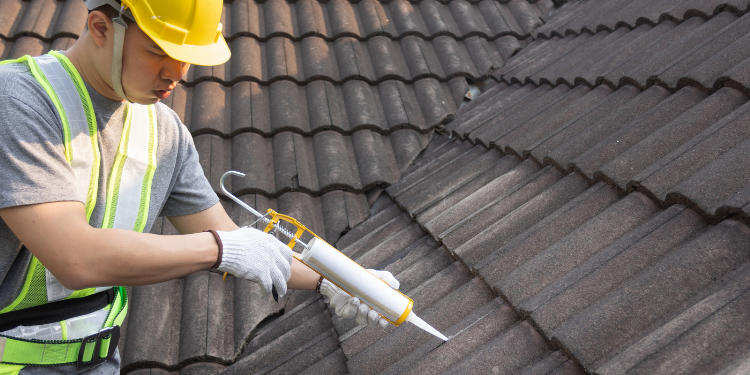Owning an RV is more than just a lifestyle choice; it’s an investment in endless adventures and freedom on the open road. However, like any significant investment, your RV requires proper care and maintenance to ensure it stands the test of time. One critical aspect of RV maintenance is the application of roof sealant. In Rockwall, Texas, where the weather can be unpredictable, protecting your RV from the elements is essential. This blog will explore how RV roof sealant serves as a crucial defense mechanism against the harsh effects of nature, safeguarding your RV and preserving its value.
Key Takeaway: RV roof sealant is a vital tool that protects your investment from weather-related damage, including leaks, UV rays, and temperature fluctuations. By applying a high-quality roof sealant, you can extend the lifespan of your RV, maintain its structural integrity, and ensure it remains a safe and comfortable home on wheels.
The Importance of RV Roof Sealant
RV roofs are constantly exposed to environmental elements that can cause significant wear and tear over time. Without proper protection, these factors can lead to costly repairs and reduce the lifespan of your RV. Understanding the importance of RV roof sealant is the first step in protecting your investment.
The Impact of UV Rays
One of the most damaging elements your RV roof faces is ultraviolet (UV) radiation from the sun. In Rockwall, Texas, where the sun shines brightly for much of the year, UV rays can cause the roof material to deteriorate, leading to cracks and leaks. Roof sealant acts as a protective barrier, reflecting UV rays and preventing them from breaking down the roof’s surface.
Protection Against Water Damage
Water damage is a common issue for RV owners, especially during the rainy seasons. When water seeps through cracks in the roof, it can cause significant internal damage, including mold growth and structural issues. RV roof sealant helps to create a watertight seal, preventing water from penetrating the roof and causing damage to the interior of your RV.
Preserving Roof Flexibility
An often-overlooked benefit of RV roof sealant is its ability to maintain the roof’s flexibility. As temperatures fluctuate, the roof expands and contracts, which can lead to cracks if the material becomes brittle. A high-quality sealant ensures that the roof remains flexible, reducing the risk of damage and extending the roof’s lifespan.
Choosing the Right Roof Sealant
Selecting the right RV roof sealant is crucial for ensuring the best protection for your RV. With various options available on the market, understanding the different types of sealants and their benefits can help you make an informed decision.
Types of RV Roof Sealants
There are several types of RV roof sealants, including silicone, acrylic, and polyurethane. Each type has its own set of advantages and is suited for different roof materials. For instance, silicone sealants are known for their excellent UV resistance and flexibility, making them ideal for areas with intense sunlight. Acrylic sealants, on the other hand, are water-based and offer easy application and cleanup, while polyurethane sealants provide strong adhesion and durability.
Application Methods
The method of applying RV roof sealant can vary depending on the product. Some sealants come in a liquid form that can be rolled or brushed onto the roof, while others are available in tape form, which is applied directly to the seams. It’s essential to follow the manufacturer’s instructions carefully to ensure proper application and maximum protection.
Considerations for Rockwall, Texas
When choosing a roof sealant for your RV in Rockwall, Texas, it’s important to consider the local climate. The hot and sunny weather demands a sealant that offers excellent UV protection and can withstand high temperatures. Additionally, the sealant should be able to resist heavy rain and humidity to prevent water damage.
The Application Process
Applying RV roof sealant is a task that requires careful preparation and attention to detail. A thorough application process ensures that the sealant adheres properly and provides long-lasting protection.
Preparing the Roof Surface
Before applying the roof sealant, it’s essential to clean the roof surface thoroughly. Any dirt, debris, or old sealant must be removed to ensure proper adhesion. Using a mild detergent and a soft brush, gently scrub the roof, paying close attention to seams and edges. Once clean, allow the roof to dry completely before proceeding with the application.
Applying the Sealant
The application of RV roof sealant should be done in sections, starting with the seams and working outward. For liquid sealants, use a brush or roller to apply an even layer of sealant, ensuring that all seams and edges are covered. If using a tape sealant, press the tape firmly onto the seams, making sure there are no air bubbles or gaps. Be sure to follow the manufacturer’s instructions for curing time, as some sealants may require several hours or even days to fully set.
Final Inspection and Maintenance
After the sealant has been applied and has had time to cure, it’s important to conduct a final inspection of the roof. Check for any missed areas or spots where the sealant may not have adhered properly. Regular maintenance is also crucial to ensure the sealant remains effective over time. Inspect the roof periodically, especially after heavy rain or extreme temperatures, and reapply sealant as needed to maintain a strong protective barrier.
Benefits of Professional Application
While many RV owners choose to apply roof sealant themselves, there are significant advantages to having the job done by a professional. Professional application ensures that the sealant is applied correctly and provides the best possible protection for your RV.
Expertise and Experience
Professional roofers have the expertise and experience to apply RV roof sealant efficiently and effectively. They are familiar with the different types of sealants and know which products work best for specific roof materials. By hiring a professional, you can have peace of mind knowing that the job will be done right the first time.
Proper Equipment and Techniques
Applying RV roof sealant requires the use of specialized equipment and techniques to achieve optimal results. Professional roofers have access to high-quality tools and materials that may not be available to the average RV owner. This ensures that the sealant is applied evenly and adheres properly, providing maximum protection.
Time-Saving and Convenience
One of the biggest benefits of professional application is the time and effort it saves you. Applying roof sealant can be a time-consuming task, especially for those who are not experienced with the process. By hiring a professional, you can save yourself the hassle and enjoy the convenience of having the job done quickly and efficiently.
Understanding the Costs
The cost of applying RV roof sealant can vary depending on several factors, including the type of sealant used, the size of your RV, and whether you choose to hire a professional or do it yourself. Understanding the costs involved can help you budget for this important maintenance task.
Material Costs
The cost of RV roof sealant materials can range from $20 to $100 or more, depending on the type and quality of the product. Silicone sealants tend to be more expensive than acrylic or polyurethane options, but they also offer superior UV protection and durability. When budgeting for materials, be sure to factor in the size of your RV roof, as larger roofs will require more sealant.
Labor Costs
If you choose to hire a professional to apply the roof sealant, labor costs will be an additional expense. Labor costs can vary depending on the complexity of the job and the experience of the roofer. On average, you can expect to pay between $300 and $500 for professional application. While this may seem like a significant investment, it can save you money in the long run by preventing costly repairs.
Cost vs. Value
While the initial cost of applying RV roof sealant may seem high, it’s important to consider the long-term value it provides. By protecting your RV from the elements, you can extend its lifespan and preserve its resale value. In the end, the cost of roof sealant is a small price to pay for the peace of mind that comes with knowing your investment is protected.
Answering Common Questions
How often should I apply RV roof sealant? The frequency of applying RV roof sealant depends on the type of sealant used and the climate in which your RV is stored. In general, it’s recommended to inspect and reapply sealant every one to two years, or as needed, to ensure continuous protection.
Can I apply RV roof sealant myself, or should I hire a professional? While applying RV roof sealant is a task that many RV owners can do themselves, hiring a professional ensures the job is done correctly and with the right materials. If you’re not confident in your ability to apply the sealant, it’s best to seek professional help.
What are the signs that my RV roof needs new sealant? Common signs that your RV roof needs new sealant include cracks, peeling, or discoloration of the existing sealant, as well as water leaks or damp spots inside the RV. Regular inspections can help you catch these issues early and address them before they cause significant damage.
The Impact of Weather on RV Roof Sealant
The weather in Rockwall, Texas, can have a significant impact on the effectiveness of RV roof sealant. The hot, sunny climate increases the risk of UV damage, while the occasional heavy rain can lead to water leaks if the sealant is not properly maintained. It’s important to choose a sealant that is specifically designed to withstand these conditions and to apply it regularly to keep your RV protected.
Weather and RV Roof Maintenance
The local climate plays a crucial role in the maintenance of your RV roof. Extreme temperatures can cause the roof material to expand and contract, leading to cracks and leaks. By applying a flexible, UV-resistant sealant, you can protect your RV from the damaging effects of the weather and ensure it remains in good condition for years to come.







